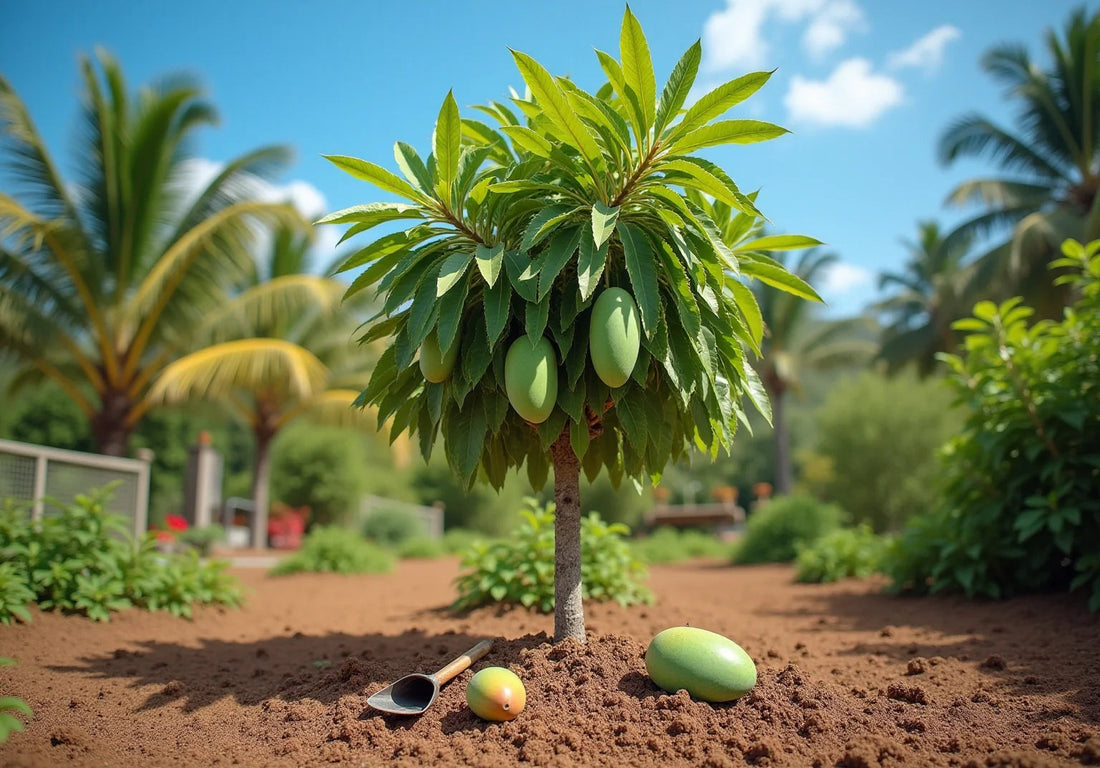
Mango Trees Online: Where to Buy & Care Tips
Share
Mango trees are not merely a tropical delight; they embody the promise of homegrown sweetness and vibrant landscapes. For gardening enthusiasts, the chance to cultivate these majestic trees offers both joy and a unique set of challenges. What does it truly require to grow and care for mango trees successfully, ensuring they thrive and yield luscious fruit?
This guide explores the essential steps, from selecting the right variety to troubleshooting common issues, equipping readers with the knowledge necessary to nurture their own mango paradise.
Where to buy Mango Trees Online?
If you're thinking about growing Mango trees, consider Mango tree collection at Everglades Farm.
🛒 Explore Nam Doc Mai # 4 Dwarf Mango Tree
🛒 Explore Alphonso Mango Tree (Grafted Mango Variety from Florida)
🛒 Explore Carrie Dwarf Mango Tree Grafted
Understand Mango Tree Basics
Mango trees online (Mangifera indica) are tropical trees that thrive in warm climates, particularly in USDA hardiness zones 10B to 11. They require full sun exposure, needing a minimum of 8 hours of direct sunlight each day to produce healthy fruit. Ideal growing conditions consist of well-drained, loamy soil with a slightly acidic to neutral pH, ranging from 6.0 to 7.5.
Understanding the growth traits of these plants is essential; they can reach impressive heights of 30 to 100 feet, depending on the variety. When choosing mango trees online, each provide unique flavors and textures, making it crucial to select the right type for your garden.
Everglades Farm's Fast-Growing Plants collection features fruit-bearing plants specifically chosen for their rapid yield and robust growth, ensuring you can enjoy homegrown produce sooner. By familiarizing yourself with these essential elements and utilizing Everglades Farm's high-quality fertilizers, you can create optimal conditions for your fruit plants, leading to a rewarding gardening experience.
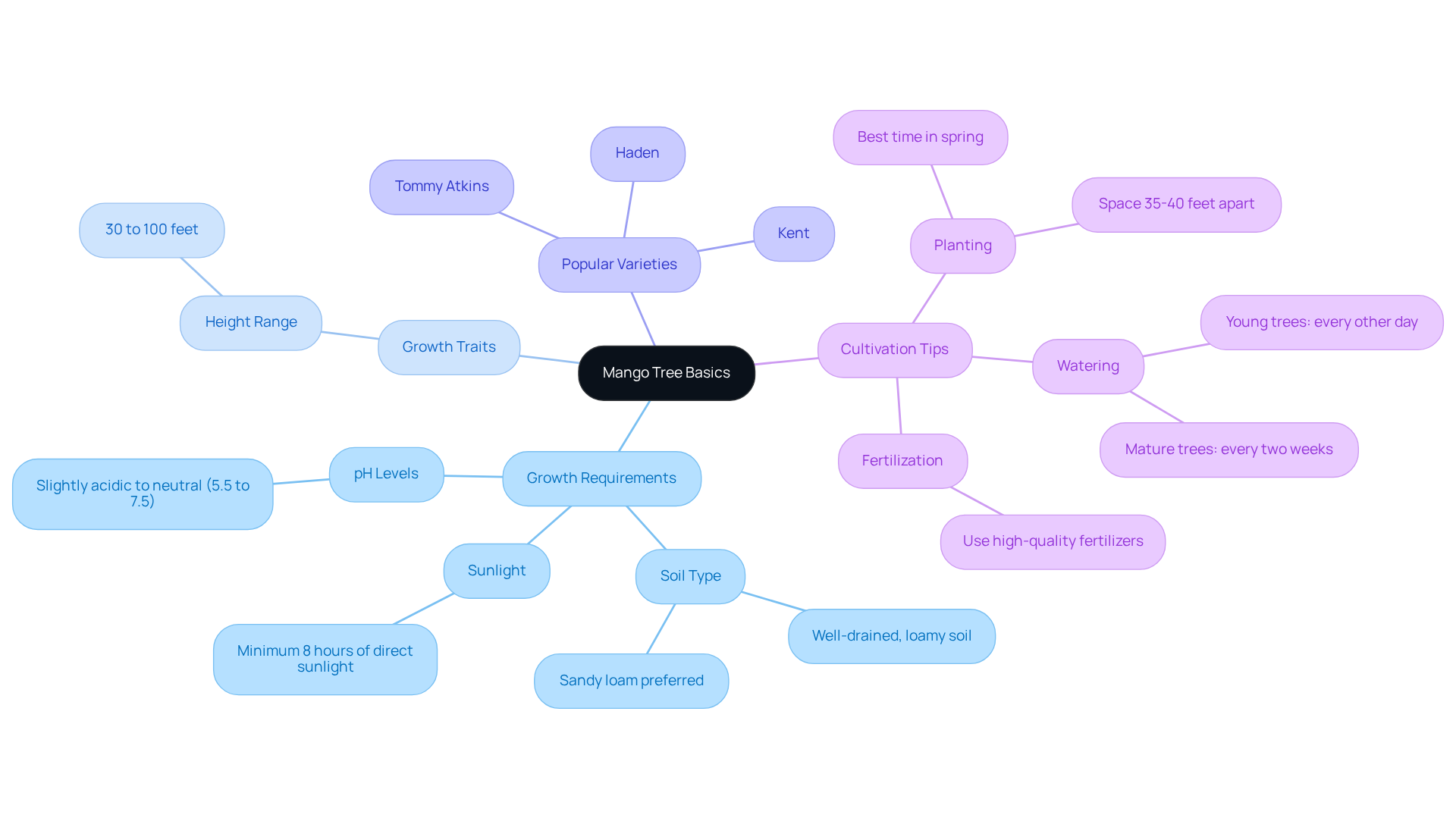
Plant Mango Trees Effectively
To plant a mango tree effectively, follow these steps:
- Choose the Right Location: Select a sunny spot in your garden that is sheltered from strong winds. Ensure the area has well-draining ground to prevent root rot, as mango trees flourish in sandy-loam textures that dislike prolonged exposure to excessive water.
- Prepare the Ground: Amend the earth with organic matter, such as compost, to enhance fertility and drainage. The comprises 40% sand, 50% peat moss or coconut coir, and 10% earthworm castings, resulting in a loose and aerated setting that fosters healthy root growth. It is also crucial to understand the pH of your ground, as this can greatly influence the development of your fruit plant.
- Dig the Hole: Dig a hole that is twice as wide and the same depth as the root ball of the plant. This allows the roots to spread easily and establishes a strong foundation for growth.
- Plant the Sapling: Position the mango plant in the hole, ensuring that the top of the root ball is level with the surrounding ground. Refill the hole with earth and gently compact it to remove air pockets, which can impede root establishment. Be cautious not to over-amend the planting hole with excessive organic material, as this can lead to future problems with the stability of the plant.
- Water Thoroughly: After planting, irrigate the plant deeply to help settle the soil around the roots. For the initial weeks, water the plant every other day to establish a strong root system, ensuring that newly planted specimens receive adequate moisture during this critical phase.
- Mulch: Apply a layer of mulch around the base of the plant to retain moisture and suppress weeds. Keep the mulch a few inches away from the trunk to prevent rot, which can happen if moisture builds up against the base.
- Pest Control: Observe your fruit plant for typical pests like aphids and scale insects. Implement organic pest control methods, such as introducing beneficial insects or using insecticidal soap, to safeguard your plant from infestations.
By adhering to these best practices, you can establish an ideal setting for your tropical plant, such as mango trees online, boosting its growth potential and yield. Remember, 79% of reviews rate Everglades Farm's service as five stars, reflecting their commitment to quality and customer satisfaction, which ensures that you receive healthy tropical fruit plants packaged with care.
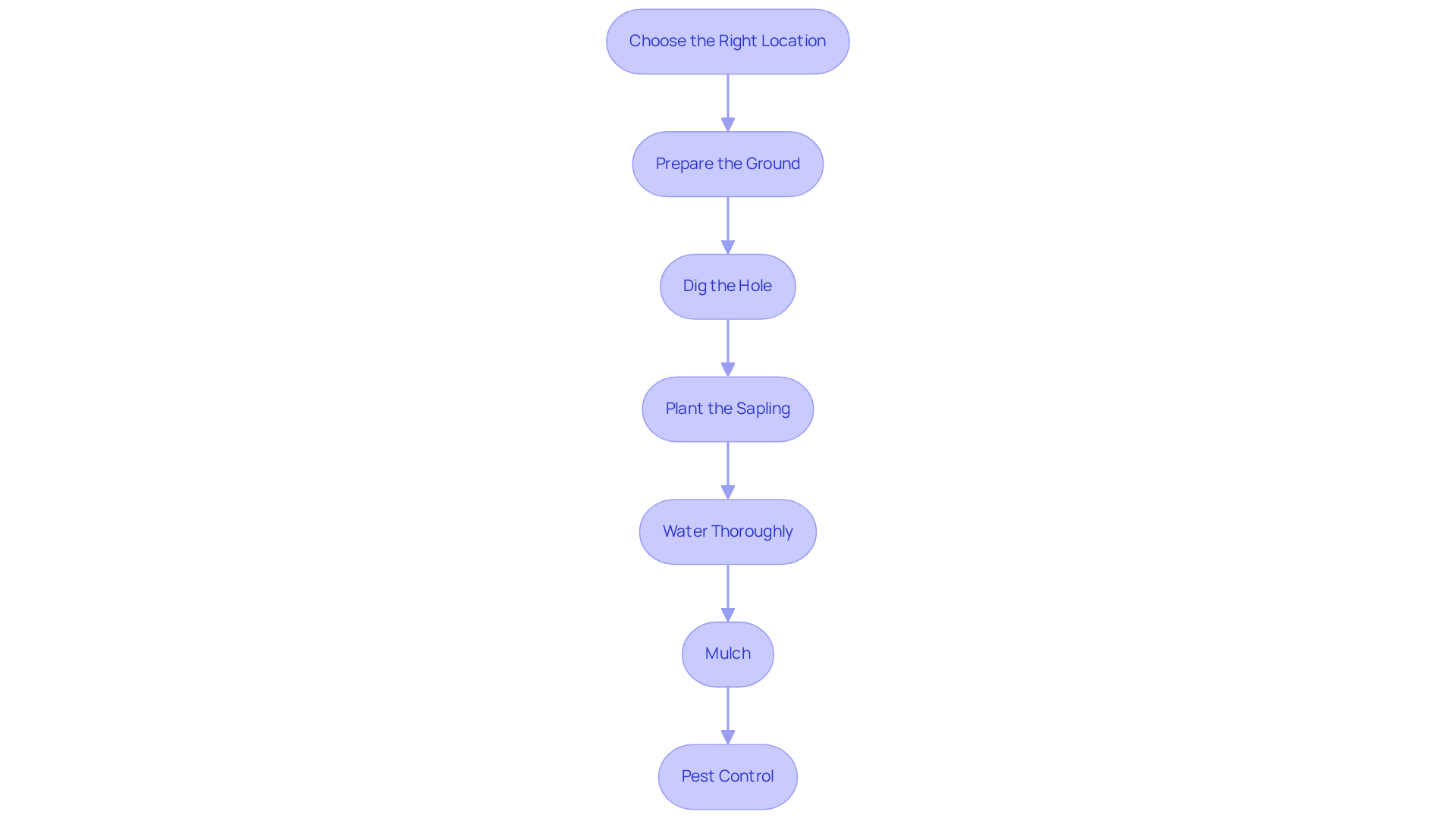
Maintain Healthy Mango Trees
To maintain healthy mango trees, consider the following care practices:
- Watering: Newly planted mango plants should be irrigated thoroughly twice a week for the initial two months to aid root establishment. After this period, reduce watering to once a week. As trees grow, modify the frequency to every 10-14 days, considering rainfall and moisture levels. It's crucial to allow the upper 2-3 inches of soil to dry out between waterings to prevent root rot.
- Fertilization: Apply a balanced fertilizer with a higher potassium content during the growing season to promote healthy fruit development. For young plants, fertilization should take place every 6-8 weeks, focusing on higher nitrogen during the early growth phases. Mature plants benefit from targeted applications during flowering and fruiting stages. Regular soil testing can help identify specific nutrient deficiencies, ensuring optimal growth.
- Pruning: for these plants to eliminate dead or infected branches and to form the structure for better airflow and light exposure. Use clean, sharp tools for pruning, making cuts just outside the branch collar to prevent disease spread. This practice not only improves the plant's structure but also promotes a strong canopy, which is essential for maximizing yield.
- Pest and Disease Management: Regular inspections for pests, such as mango flies, and diseases like anthracnose are essential. Utilize natural pesticides or fungicides when needed, and uphold proper cleanliness by removing fallen produce and debris in the vicinity. Look for signs of nutrient deficiencies, such as yellowing leaves or poor fruit quality, to address potential issues early. This proactive strategy aids in avoiding infestations and enhances overall plant health.
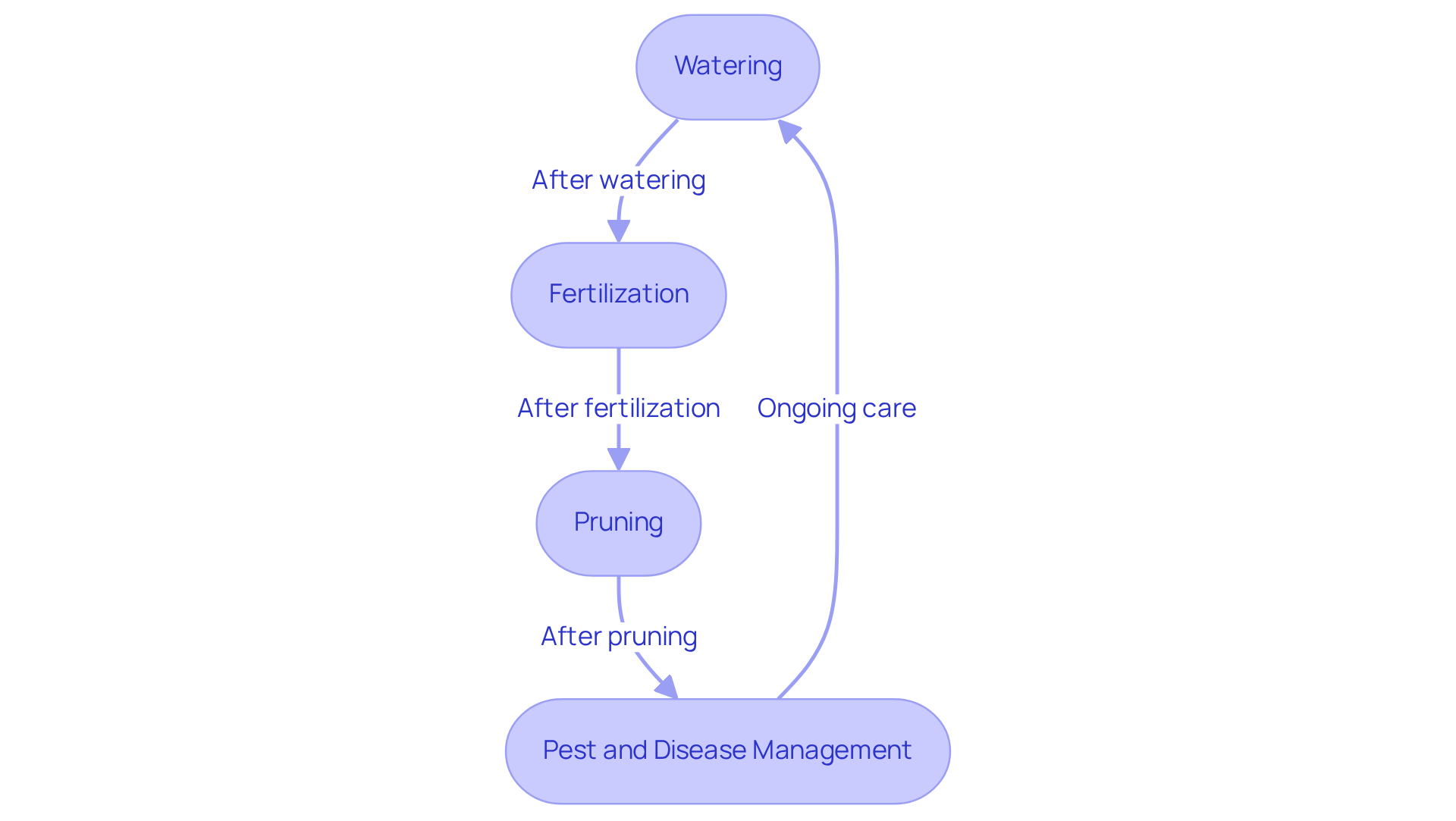
Troubleshoot Common Mango Tree Issues
Mango trees online can encounter several common issues that affect their health and productivity.
- Leaf Yellowing: This often indicates overwatering or nutrient deficiencies, particularly nitrogen or potassium. To remedy this, ensure proper drainage and consider conducting a to assess nutrient levels. Applying a balanced fertilizer can help restore vigor.
- Poor Fruit Set: If your tropical plant fails to yield produce, it may be due to insufficient sunlight or inadequate fertilization during the flowering phase. Ensure the plant receives a minimum of six hours of sunlight each day and consider utilizing a high-quality fertilizer to aid in produce development.
- Pest infestations caused by typical pests such as flies and aphids can greatly affect mango trees online. Look for signs of infestation, such as damaged produce or sticky residue on leaves. Employ organic solutions like insecticidal soap or neem oil to effectively manage these pests while minimizing harm to beneficial insects. For fly infestations, consider using biological control agents like Diachasmimorpha longicaudata to improve your pest management strategy.
- Diseases: Fungal diseases, such as anthracnose, manifest as black spots on leaves and fruit. This illness is among more than 52 fungal conditions impacting fruit plants globally. To combat this, apply a fungicide at the first sign of infection and ensure good air circulation around the plant to reduce humidity, which fosters fungal growth. As noted by plant pathologists, several infectious diseases caused by many phytopathogens are deteriorating the quality and quantity of mango trees online.
- Root Rot: Frequently triggered by excessive watering or inadequate drainage, root rot can result in plant mortality. If you suspect root rot, reduce watering and enhance drainage in the ground. In severe cases, replanting the tree in fresh, well-draining soil may be necessary to restore its health.
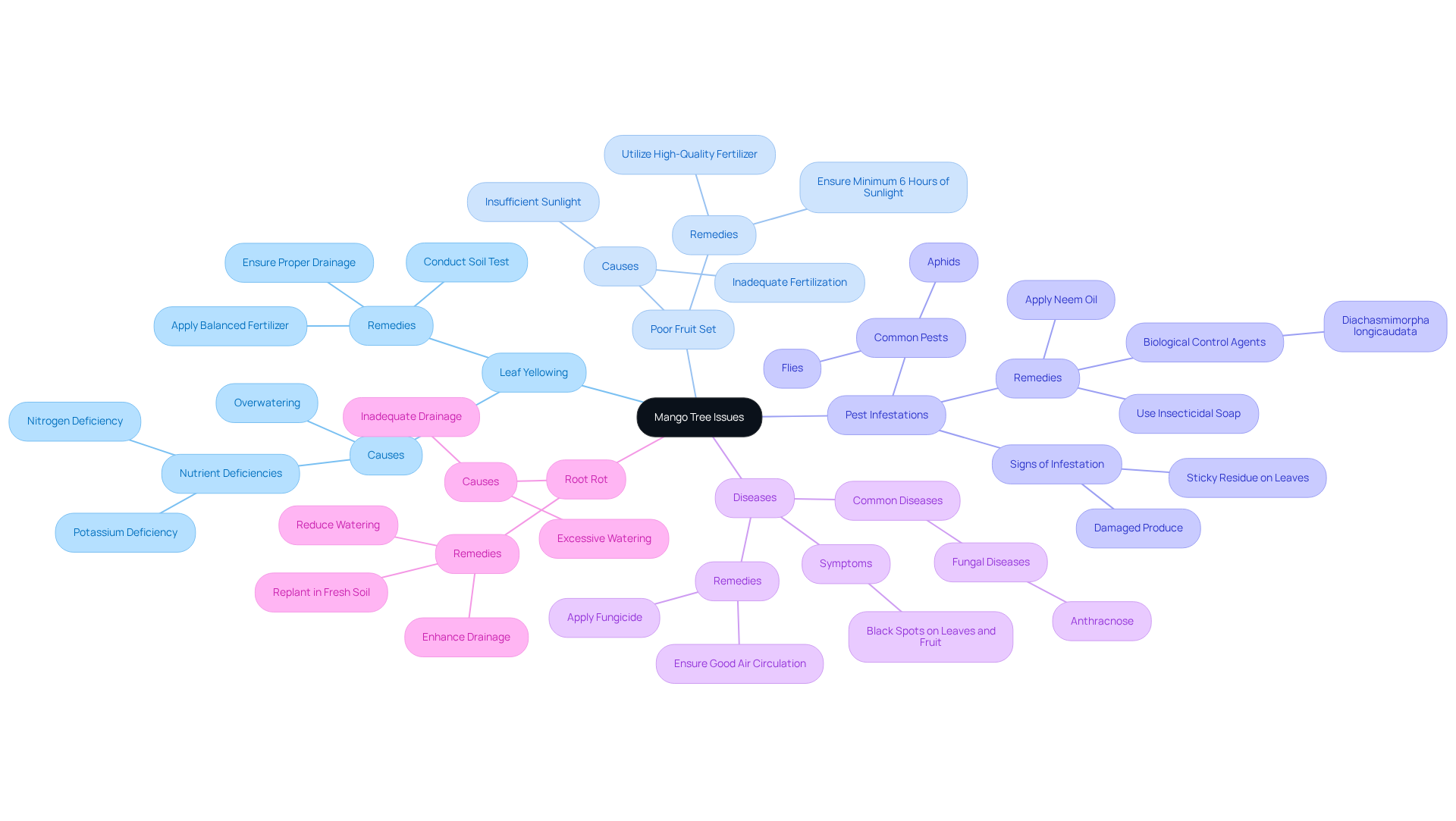
Conclusion
Mango trees provide a delightful addition to any garden, offering not only lush greenery but also the promise of delicious fruit. Successfully growing and caring for these tropical trees necessitates a solid understanding of their unique needs, including optimal sunlight, soil conditions, and maintenance practices. By adhering to the outlined steps and recommendations, gardeners can ensure their mango trees thrive and yield bountiful harvests.
Key points discussed include the significance of:
- Selecting the right location
- Employing proper planting techniques
- Maintaining ongoing care such as watering, fertilization, and pest management
Each of these factors plays a crucial role in establishing a healthy mango tree capable of withstanding common issues like leaf yellowing and root rot. By being proactive and attentive, gardeners can mitigate many challenges that may arise during the growth process.
Cultivating mango trees transcends merely planting; it embodies nurturing a rewarding experience that can lead to fruitful outcomes. Whether choosing a popular variety or experimenting with different types, the journey of growing mango trees can be both fulfilling and enjoyable. Embrace the opportunity to cultivate these tropical beauties and savor the fruits of your labor, both literally and figuratively, as you create a vibrant garden space.
Cultivate Your Own Tropical Paradise Today!
Start your journey with Everglades Farm and enjoy the sweet rewards of homegrown mangoes.
Frequently Asked Questions
What are the basic requirements for growing mango trees?
Mango trees thrive in warm climates, specifically in USDA hardiness zones 10B to 11. They require full sun exposure, needing a minimum of 8 hours of direct sunlight each day, and prefer well-drained, loamy soil with a slightly acidic to neutral pH, ranging from 6.0 to 7.5.
How tall can mango trees grow?
Mango trees can reach impressive heights of 30 to 100 feet, depending on the variety.
What are some popular varieties of mango trees?
Popular varieties of mango trees include Haden, Tommy Atkins, and Kent, each offering unique flavors and textures.
How can I ensure a successful mango tree planting?
To ensure a successful planting, familiarize yourself with the essential growing conditions and utilize high-quality fertilizers, such as those offered by Everglades Farm, to create optimal conditions for your mango trees.
What is the advantage of choosing fast-growing mango plants?
Choosing fast-growing mango plants, like those from Everglades Farm's Fast-Growing Plants collection, allows you to enjoy homegrown produce sooner due to their rapid yield and robust growth.


